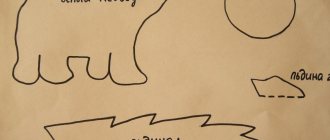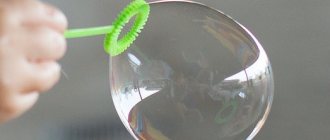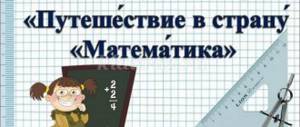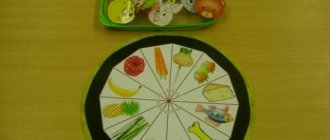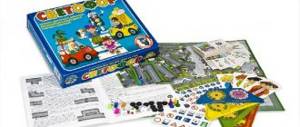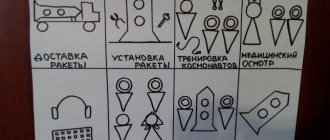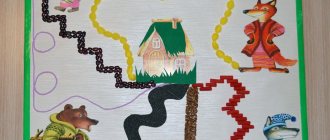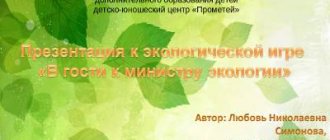Active movement is an important condition for the development of our children. The best way to encourage a child to be active is to play interesting, active games. The game "Bear and Bees" will be interesting for both boys and girls of pre-school return. In addition to entertainment, it is a useful set of breathing exercises and improves the functions of the respiratory system.
Tasks
- Teach children to run in different directions without bumping into each other.
- Start the movement and change it at the teacher’s signal.
- Find your place.
- Learn to climb a gymnastic wall and overcome obstacles.
- Develop dexterity.
HEALTHY! When playing the game for the first time, you can ask the children riddles so that they can guess who they will portray.
| Clubfoot and big, He sleeps in a den in winter. Loves pine cones, loves honey, Who will call him for us? | |
| It's brown and big Sleeps in a den under a pine tree. And in the spring it will begin to roar The clubfooted beast... | |
| The beast waddles For raspberries and honey. He loves sweets very much And when autumn comes, Climbs into a hole until spring, Where he sleeps and dreams. | |
| She buzzes over the flower, He quickly flies towards the hive, I gave my honey to the honeycomb, What is her name? | |
| I buzz loudly as I fly, Collecting healing honey. Helpful and nice to everyone Striped… | |
| Flew over flowers Flew over the fields. She buzzed merrily. I picked up some nectar. And carried the spoils Straight to your home... |
Exercise about a bear cub
This exercise is recommended for children aged 18 months to 3 years. It includes text describing the plot and finger movements to visualize the entire action. Speech accompaniment of gymnastics is important for the child to comprehend and construct the image of his actions - finger games form figurative-associative and logical thinking. The thumb and little finger of the right (or left, for left-handed) hands represent the paws of a bear cub, the remaining fingers should be pressed to the palm and used as needed:
- The clubfooted bear was walking through the forest (his fingers depict a waddling gait).
- I chose a place for my den.
- He began to dig the ground under a tall pine tree (the left hand represents a pine tree - place it on your elbow and open your fingers, crossing your “paws” at the elbow)
- I dug a den and went to bed. (the left palm covers the right one - the bear).
- Stars - snowflakes fell from the sky (handles are raised up and, moving their fingers, slowly lowered down).
- The paths, houses, and forest were covered in snow (the wavy movements show how the ground is covered).
- And the wind shook the trees all winter (with hands they depict swaying branches).
- And all winter the bear slept sweetly (palms folded under his cheeks, eyes closed).
Finger gymnastics “Teddy bear” is loved by many children; in children's centers it is usually performed with musical accompaniment. This exercise develops plasticity of movements, flexibility of fingers, imagination and artistry - after a while, having learned the poem by heart, the child can put on a small performance in front of the whole family, earning sincere applause.
Preparation and rules
All players are divided into “bees” (there should be more of them) and “bears” (2-4 people). Up to 12-15 people can participate in the game. “Bees” live in a “hive” - on the gymnastics wall. Near it, it is necessary to select a “meadow with flowers” zone, to which the “bees”, at the command of the teacher, flock and collect honey. Pictures of flowers are laid out in the “meadow”. Behind the meadow there is a second zone - the “forest” (“den”), where the “bears” live. At the teacher’s command, they run out of the “forest” and climb into the “hive” (on the wall).
After the next command from the teacher, the “bees” begin to catch up with the “bears” and “sting” (salt) them, and the “bears” run away from them into the “forest”. At the same time, on the way to the “forest” there may be obstacles - “logs” or “pits” that must be overcome. The "bees" return to the "hive". "Stung Bears" do not participate in the next game. So the game is repeated several times until all the honey lovers are “stung”. Then you can change the children's roles and resume the game.
An example of the game is shown in the video:
The following tools can be used to play:
| Tool | Purpose |
| Bee and bear costumes | A group of children puts on “bee” costumes (masks) - they will fly in the “meadow” and sting the “bears”; the second group of children accordingly puts on “bear” costumes (masks) - they will climb for honey |
| Gymnastic wall | Used as a "bee hive". “Bees” will sit on it and “bears” will climb on it to enjoy the honey. |
| Benches | They are used as “logs” – an obstacle for “bears”. It is necessary to crawl over them or climb over them before escaping into the forest |
| Hoops | “Pits” or “puddles” are also an obstacle for children. They shouldn't step into hoops |
| Flower cuttings | They are located on the floor in the “meadow”. "Bees" fly and collect nectar from them |
ATTENTION! It is necessary for the teacher to be at the “beehive” (gymnastic wall) in order to provide assistance to the players if necessary.
ADDITIONALLY! To select “bears” you can use a counting rhyme. All children stand in a circle and, together with the teacher, repeat the poem several times until the required number of players is selected:
A clubfooted bear is walking through the forest,
He collects cones and sings a song.
The cone flew off - right into the bear's forehead!
The bear got angry and kicked - TOP!
About the clubfoot bear and other poems and finger games
Maksimka is 1 year and 10 months old. And he has a favorite teddy bear with which he always goes to bed. And when he wakes up after a nap, he comes to me with the bear, all sleepy, not yet awake. And then for some time she still walks around hugging him. On this occasion, I remembered a poem about a clubfoot bear and began to tell it to my son. She also staged a mini-performance (or what is it called?):
The clumsy bear walks through the forest, collects pine cones and puts them in his pocket.
Suddenly a cone fell right on the bear’s forehead, the bear got angry and stomped his foot!
“I won’t collect any more cones, I’ll get in the car and go to bed!”
Now, whenever my son wakes up, he shows me that I need to take out the pine cones and act out the story about the bear.
And recently (since winter is just around the corner) I remembered the children’s song “Once in a Frosty Winter,” where it is also sung about a bear, and I made another mini-scene:
One frosty winter along the edge of the forest
The bear was walking to his home in a warm fur coat.
He walked, walked to his den along a country road
And, walking across the bridge, he stepped on the fox's tail.
The fox raised a cry, the dark forest rustled,
And the bear, out of fright, instantly climbed onto a large pine tree (on our WALL)...
well, etc., but the result is the same - ... the bear decided that he needed to sleep in winter ...
My son also loves to just read poetry, for example, Agnia Barto about toys. His favorite poem is about a bull. Previously, the son simply imitated how the bull rocked, but now he himself finishes the poem:
Me: The bull walks, swings, sighs as he goes: “Oh, the board is ending, now I...
Son: Bam, bam (which means “fall” - I’ll fall)
And more about the plane:
Me: We’ll build the plane ourselves, we’ll fly over the forests, we’ll fly over the forests, and then we’ll come back...
Son: Mom (to mom)
And recently I found a good selection of finger games, my son liked them so much that now he asks to do them all the time:
1. The white-sided magpie cooked porridge and fed the children. She gave to this, she gave to this, she gave to this, she gave to this, but she didn’t give to this: you didn’t carry water, you didn’t chop wood. She didn't give me any porridge. (We move from the center of the palm to the edges, pinch the fingers, starting with the little finger, and click the thumb harder)
2. One, two, three, four, five. Let's count fingers. This finger found a mushroom, this finger washed the table, this one cut it, this one ate it, but this one just looked. (We bend our fingers one by one)
3. This finger wants to sleep, this finger jumped into bed, this finger took a nap, this finger was already asleep, this finger slept for a long time, and then began to wake everyone up. The fingers stood up: “Hurray.” It’s time for us to go for a walk” (We bend our fingers one by one, and then open our entire palm)
4. The fingers played hide and seek and the heads were removed. Like this, like this, and the heads were removed (rhythmically bend and straighten your fingers)
5. Little finger, where have you been?
- With this finger I went into the forest, with this finger I cooked cabbage soup, with this finger I ate porridge, with this finger I sang songs (the child’s fingers are fingered one by one)
6. Here is a fist, and here is a palm. A cat sat on your palm
And she went, she went, she went, she reached the armpit (we go with our fingers to the armpit and tickle)
7. Ivashka was walking to fetch water and saw his grandfather with a beard. He showed him the wells:
here (we press on the wrist) the water is cold, (we stamp our fingers up the arm), here (we press on the bend of the elbow) the water is warm, (we stamp further), here (we press on the shoulder joint) the water is hot, and here it’s boiling water (armpit), boiling water -tickles! (tickle the armpit)
8. We chop and chop the cabbage, we salt and salt the cabbage,
We rub and shake the cabbage, we squeeze and squeeze the cabbage. (
movements with straight palms up and down, alternately stroking the fingertips, rubbing fist against fist, clench and unclench fists
) 9. There is a lock on the door.
Who couldn't open it? ( fingers in the “lock”)
We tapped the lock (
knock on the table)
, We turned the lock, we twisted the lock (
circular movements with the “lock”)
And opened it! ( showed palms
) 10. A cuckoo walked past the market (we walk along the table on the index and middle fingers) She had a basket (palms connected with a “bucket”) And the basket fell on the floor - bang! (we hit our knees with closed palms, separate our hands) Ten flies flew! (we spread our arms to the sides, wiggling our fingers)
11. We shared an orange. (Hand in a fist)
There are many of us, but he is alone! (Turn your fist to the right - to the left.) This slice is for the hedgehog, (With the other hand we straighten the fingers folded into a “fist”, starting with the thumb.) This slice is for the siskin, (We straighten the index finger.) This slice is for ducklings, (We straighten the middle finger .) This slice is for kittens, (We bend the ring finger.) This slice is for the beaver, (We bend the little finger.) Well, for the wolf - the peel. (We turn the open palm left and right.) He is angry with us - trouble! (We show the cleft palate with both hands.)
We hide in the house - here! (We make our hands a “house.”)
12. “The children ran along the river in a race” (index and middle fingers “run” across the table).
At first I showed him the simplest finger games - the first 3 points. And then about the castle, and about the cabbage, and about the orange. My son liked it so much, he himself later showed me what exactly he wanted: he would either run his finger over the palm of his hand (a white-sided magpie), or clasp his hands together, or “chop” the cabbage. And yesterday, not on his hand, but on both of my hands, he himself showed the white-sided magpie in turn: he made circles and pulled his fingers. I only told the text.
This is how my son is growing up!
Synopsis of a joint educational activity on physical education for children of the 1st junior group in kindergarten
Summary of joint organized educational activities for children of primary preschool age “Bumps for babies”
This summary is addressed to physical instructors and teachers working with children of primary preschool age, as well as in the conditions of an advisory center (children from 1 to 2 years old who do not attend kindergarten kindergarten together with parents) Goal: to instill interest in physical education together with an adult. Program content: • Develop the ability to listen to instructions from an adult; • Practice walking with a stomping step, crawling on all fours in a straight direction; • To consolidate knowledge about the main parts of the body: • To promote in parents and children a feeling of joy, pleasure from playing together, and emotional closeness between parent and child. Equipment: bear toy, cones according to the number of children, basket, massage paths, tunnel, audio recording of calm and cheerful music. Introductory part Children and adults go into the hall, stand in a circle near the instructor with a bear toy in their hands. Instructor: Hello guys, hello adults, I'm glad to see you in our hall. Look who came to visit us today? This is Mishka. Let's say hello to Mishka. Guys, please show me where Mishka’s paws are (tummy, back, head, nose, ears)? Where are the guys’ hands (tummy, head, nose)? Children show the named body parts of the toy and themselves. Instructor: Now Mishka will dance for you, and you clap for him! The instructor with a toy in his hands walks in a circle and dances. Instructor: Guys, did you like how the bear danced? Let's dance with him! To the accompaniment of folk dance music, children together with adults perform dance movements (turns, stomps, “springs,” claps) as shown by the instructor. Instructor: Well done guys, they danced merrily. Look, the bear brought us a basket from the forest, what’s in it? That's right - cones! Come and take the cones! Children sort out the cones. They look at it, touch it and roll it between their palms. Instructor: Let's play with the cones! We turned behind each other and got ready to walk! An exercise in alternating running and walking with a stop at a signal - lift the cone up. Repeat 3 times. After walking and running exercises, form a circle. Instructor: The children were walking through the forest, looking for cones on the ground! Main part. Outdoor switchgear with fir cones. 1. “The children showed the cones and put them behind the back.”
I.P.
main stance, bumps behind the back. 1-2 - raise your arms forward, show bumps, 3-4- I.P. - 4 times. 2. “You need to play with the cone. You need to shake the cone.”
I.P.
main stance, bumps at the chest. 1 - turn to the right, 2 - I.P., 3-4 the same to the left. - 4 times. 3. “We’ll play with the cones. We put them down and pick them up”
I.P.
standing, legs slightly apart, bumps below. 1 - sit down, put the cones on the floor, 2 - stand up, show your palms, 5-6 - sit down, take the cones. 7-8 – I.P. - 4 times. 4. “We want to play with cones, Jump high with them”
I.P.
standing, legs slightly apart, cones in hands below. Perform jumps in place on 2 legs. Instructor: Well done guys, they played fun, the bigwigs were tired. We will follow each other and collect cones in a basket! We'll sit down and relax! Instructor: Guys, did you like playing with the cones? Now let's teach our fingers to play. (Children sit down.) Finger gymnastics “The cones are showing off”
The cones are showing off,
- We show our fists
Everyone admires them
- We shake our fists Hedgehogs
walked along the path,
- We join our palms
We found cones under a pine tree
- We spread our fingers to the sides
How good they are
- Let's clap our hands
These cones and hedgehogs!
It is carried out 2 times. The second time, children perform gymnastics with adults, the instructor prepares the equipment, and places the bear in the tunnel. Instructor: Smart guys! We had fun playing with the bear gift! Oh, guys, look, our bear is getting ready for winter and hid in his den! Today we will also be cubs and learn to hide in a den. 1-2-3 we spun around and turned into bear cubs! OVD: 1. Crawling on all fours in tunnels of various heights (90 cm, 70 cm, 50 cm). 2. Walking along the massage paths with a stomping step. Repeat 2 - 3 times. Instructor: Agile cubs, they crawled quickly and stomped loudly! 1-2-3 we spun around and turned into kids! Our legs are tired! We'll have a little rest and swing on the balls! Game exercise “Let's swing
” Adults help children lie on the balls - fitballs on their stomachs and, holding the child, rock the ball from front to back.
The instructor puts away the equipment. Instructor: Bear wants to play a fun game with us goodbye. Outdoor game “Teddy bear”. Children approach the bear and perform the actions according to the text: A bear with clumsy feet is walking through the forest. Walking with his legs apart, swaying.
He collects the cones and puts them in his pocket.
Bends down.
Suddenly a cone fell right on the bear’s forehead.
We stroke the forehead, frown.
The bear got angry and stomped with his foot!
We stomp our feet loudly and run away from the bear into the house (on the bench).
The children run away, and the Bear catches up with them.
The game is repeated 2-3 times. Final part: Instructor: Mishka didn’t catch up with anyone! Did you guys like playing with Mishka? Guys, it’s time for Mishka to get ready for winter, go to bed in a warm den, and it’s time for us to say goodbye! Goodbye! Walking around the hall. The children leave the hall.
We recommend watching:
Do-it-yourself sports equipment for kindergarten Indicators of physical fitness of children of senior preschool age Physical leisure activities for children of the 1st junior group together with parents on the topic: Spring Summary of physical education classes in the 1st junior group of a preschool educational institution
Similar articles:
Physical development of children from 5 to 7 years old
Physical development of a child from 1 to 3 years
Physical development of a child from 3 to 5 years old
